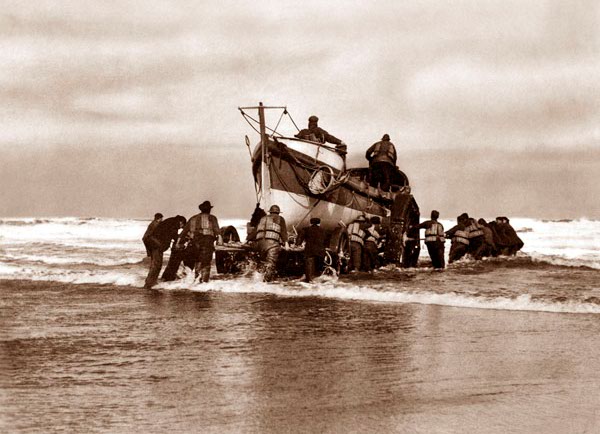We bring two tales of rescue from Whitby, one at sea and one after dragging the lifeboat ‘Robert Whitworth’ overland for six miles to avoid a raging sea before launching into Robin Hoods Bay on the north east coast of England.
28 October 1880
Silver Second-Service Clasp awarded to Coxswain Henry Freeman for launching the number one lifeboat ‘Robert Whitworth’ on 28 October, 1880 four times to vessels in distress. At about 1200 with an east-north-easterly hurricane blowing and extremely high seas the lifeboat went to assist the schooner Reaper that was drifting rapidly towards rocks and took off her four man crew. At 1330 the lifeboat assisted the fishing yawl Good Intent and saved her crew of eight. The number two lifeboat ‘Harriott Forteath’ launched at 1515 to the Rye schooner ‘Elizabeth Austin’ also stranded on the beach and immediately took off her crew of five. At 1630 the Great Yarmouth schooner ‘John Snell’ was seen making for the beach with tremendous seas continually sweeping over her. After she struck, the number one lifeboat launched for the third time and saved her five man crew. Every one of these rescues was carried out under great difficulty with Henry Freeman as coxswain.
19 January 1881
On 19 January, 1881 a fierce storm drove a vessel onto the dangerous rocks at Robin Hoods Bay and, owing to the distance and raging sea, it was decided to go to the rescue overland. It seemed a hopeless task for deep snow drifts blocked the bleak country road to the bay. Assisted by a small army of helpers and horses the lifeboat ‘Robert Whitworth’ was dragged six miles over a hill and moorland. The journey took two hours. The crew of the wreck were rescued.




These iconic images of Whitby are from the Frank Meadow Sutcliffe Collection, Whitby, held by the Whitby Museum since October 2022. Frank Meadow Sutcliffe (Hon. FRP.), active between 1875 and 1910, was probably one of the greatest photographers of his day. He won over 60 gold, silver and bronze medals from exhibitions around the world. His large camera was made of mahogany with brass fittings and it took ‘whole plate’ glass negatives (6.5″x8.5″).
RNLI
Whitby Lifeboat Station, RNLI
Whitby Museum

You must be logged in to post a comment.